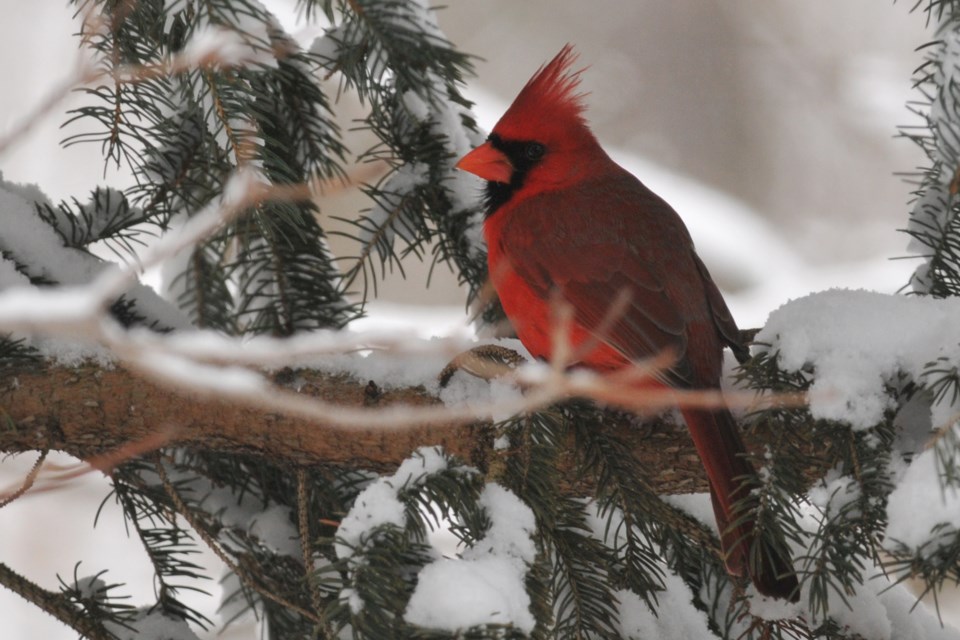What’s up with all the cardinals this year? They are everywhere! These bright red birds can be found on postage stamps, coffee mugs, calendars and just about every Christmas card in production. When did this species unofficially become our ‘official’ commercial bird of winter?
There was a time when blue jays and chickadees dominated the marketplace, at least for the snowy months; summer time cards and calendars are still strongly occupied by common loons (a distant second being owls, both real and fanciful).
Cardinals certainly have the seasonal colour box checked off, especially when viewed against a snow-covered pine branch. I am pretty sure every person who sets out a bird feeder has a moment of sheer delight when a cardinal, male or female, drops in for a visit. I know I do.
Despite their ubiquitous presence these days on all things commercial, cardinals are what some birders may consider as ‘newcomers’ to this northern part of Simcoe County. (Mind you, those birders referred to are now rather white of hair.) But in 1938 the sightings of red birds skulking about in the shrubbery was newsworthy stuff.
Within O. E. Devitt’s 1967 book The Birds of Simcoe County he includes some history of the arrival of this species to the county. The first record was from Penetanguishene when a female cardinal was collected (’shot’) by a Mr. Young in February of 1901. Next entries are in 1926 (Collingwood) and then in 1933 (Barrie) by Dr. Brereton (Aside: Dr. Brereton was the namesake of the original naturalists’ club in Simcoe County, the Brererton Field Naturalists Club, now called Nature Barrie).
In 1938-39 a huge influx of cardinals was noted across the landscape and thereafter they became what birders refer to as ‘uncommon seasonal transients’ but consistently in the area. Big news happened in 1941 when a nest with young was confirmed in Orillia. A ‘breeding’ species trumps an ‘uncommon transient’ in spades.
This first recorded breeding pair actually arrived in 1939, regularly going to a feeding station operated by a Mr. Schell in Orillia. This made the news in the March 6 1939 edition of the Toronto Globe and Mail newspaper.
But wait, there’s more… in June of 1941 a nest with three young was found in a honeysuckle shrub (eight feet above the ground) on the McGill property on Tecumseth Street! It appears that the Schell birds were actually nesting in the neighbouring McGill property.
By the 1960s cardinals were becoming a bit more common place in the county. When my Mom and 12-year-old me joined the Brereton Field Naturalists in 1967, the sighting of such a brilliantly coloured bird was till cause for excitement.
As we gathered to car pool for our first field trip at Bill and Marion Cattley’s house, another member, Fred Noakes, eagerly pointed out to us the furtive movements of a bird in the shadows. A hop up to a branch in the open placed the bird directly in a shaft of early morning sunlight… oh, wow, my birdwatching career suddenly and gloriously kicked into place!
Fifty-some years later, cardinals still ignite that “oh, wow” sensation within me, and a lot of other people, too! While many will place out sunflower seeds in hopes of visits by blue jays and chickadees, we all know that, really, it is the arrival of a cardinal that will make or break the status of our feeding station.
That range extension so noted in 1939 is a good example of how nature is never static, that change is constant, that today is different than yesterday. Despite it being in the neighbourhood of 12,000 years since the Wisconsin glacier up and melted away, our area still recovers from the impacts of the ice fields.
In the study of nature, there is a well-known process called succession whereas one plant community will take advantage of and then succeed over another: from sand to grass, from grass to shrubs, from shrubs to sun-loving trees, from sun-loving trees to shade-tolerant hardwood forests.
As each plant community arrives then thrives, so too do the associated wildlife species. Cardinals love a good shrub zone but also a winter that doesn’t freeze its feet to the branches. Therefore, the ‘banana belt’ as it was called in Ontario, the Guelph-London zone, became the stronghold of cardinals for a few decades.
Indeed, it was in Guelph, while attending a Nature Canada conference in May of 1980, that I received an unusual lesson in cardinal behaviour. As the sun rose over the city and I struggled to maintain just a few more minutes of sleep, some yahoo was whistling for his dog to come, right outside my window! Grrr! Not impressed.
An hour later, as we left the building, that guy was still whistling for his dumb dog to come. I rounded the corner to let him know, in no uncertain terms, that his incessant whistling was actually a bother and why don’t you leash your wandering dog… when a splendid individual dressed in bright red feathers was found to be whistling to his mate!
So as you open what I hope is a pile of cardinal decorated Christmas cards proclaiming to you well wishes and great happiness, remember to cast a view outside from time to time ... the original may be sneaking off with a gifted sunflower seed or two.
